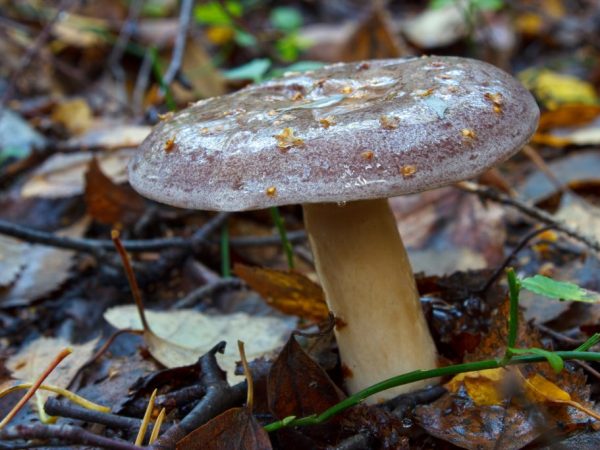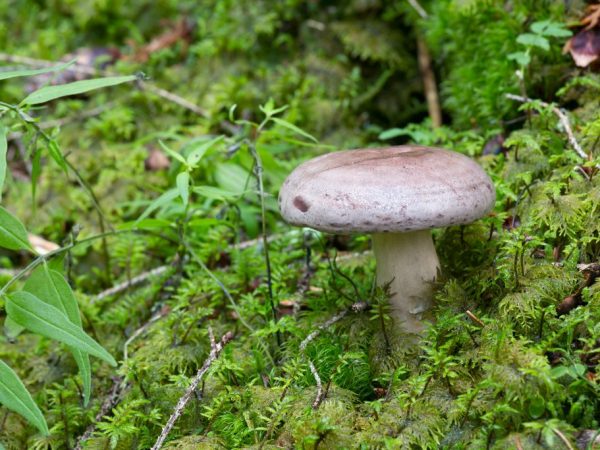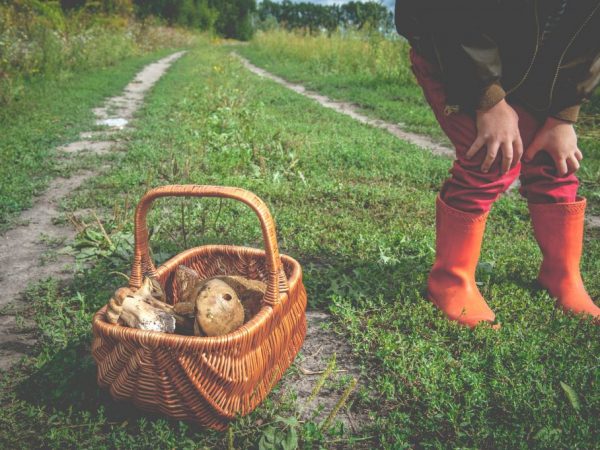Conditionally Edible Gladysh Mushroom
Gladysh mushroom is a representative of the lamellar fungi of the genus Mlechnik, belonging to the russula family. It is conditionally edible.

Conditionally Edible Gladysh Mushroom
Botanical characteristic
In the smooth mushroom, the cap grows up to 8-15 cm in diameter. It is thick-fleshed in structure. The shape of the cap in young specimens has the form of a hemisphere or convex; as the fungus matures, it becomes depressed-flattened, in its central part there is a depression. The hat edges are bent towards the mushroom stem. Concentric circles on the surface can be seen only in very young mushrooms and they will be extremely weak. The surface is slimy; in wet weather, its amount increases. The shape may not be correct. The color is different: from lilac with purple to brown. Overripe mushrooms change color to yellowish with a lilac tint or brown and pink.
The scientific name of the mushroom is common lactarius. The people call him a gray milk mushroom, a smoothie, a pig, an alder and a yellow nest.
The length of the mushroom leg is 5-10 cm, in some cases - up to 15 cm. The shape is even, smooth, in the form of a regular cylinder, less often - swollen at the base. In mature mushrooms, the inside is empty (hollow). The color of the mushroom leg is similar to the color of the cap, sometimes it has a yellow tint.

The mushroom cap has an irregular shape, its surface is covered with mucus.
The hymenophore plates descend onto the mushroom stem. The color is initially closer to white, then takes on a fawn tint. Under mechanical action, it becomes gray-green as a result of the action of the secreted milky juice.
Gladushki are classic representatives of the genus Mlechnik of the class Basidiomycetes. They produce a creamy spore powder in basidia.
The mushroom pulp of young mushrooms is strong in structure, and looses over time. White color. When pressed or on a break, a burning milky white juice is released, which, when dried, turns olive brown. Milky juice has a pungent smell, similar to the smell of herring, as well as a bitter taste.
Geography of distribution
The geography of distribution of the common lactarius covers the Eurasian territory, especially the northern regions, in the southern regions the number of mushroom colonies is much less.
The fungus is often found, prefers to grow in large colonies, in rare cases it occurs singly. Able to form mycorrhiza with pine, spruce and birch roots. In regions where alder grows, smooth mushrooms settle in the thickets of these trees, therefore they are also called alders.
Active stable fruiting in ironies begins in the second half of summer and ends in the second half of autumn.
Gladysh prefers moist places, therefore it often grows among moss and thick grass away from sunlight, often near sphagnum bogs. The main places of growth are forests, often deciduous and mixed types. He chooses sandy loam and clay soils and land rich in limestone.

The geography of distribution covers the Eurasian territory, especially the northern regions
Similar varieties
In nature, there are types of ironies that are similar in description, including:
- Miller meat-red: differs from the original in dark orange or brown color of the mushroom cap, contrasting specks on the stem and a strongly pronounced specific smell.
- Serushka: differs from a smoothie in a smaller amount of mucus contained on a mushroom cap, a cottony structure of a leg and, less often, planted hymenophore plates. Mushroom pickers often call these mushrooms pods, bitters, gray and purple milk mushrooms.
Practical use
Gladushka belongs to the 4th, relatively low, gastronomic category, which includes conditionally edible mushrooms. However, the smoothie is not inferior in taste to the classic volushka and has iodine, potassium, sodium and phosphorus useful for health in its chemical composition. Since it is a conditionally edible mushroom, it is permissible for food use only after prolonged soaking.
Irina Selyutina (Biologist):
Unlike Russian cuisine, where smoothies are subjected to long-term pre-processing (soaking, repeated boiling with the removal of the broth), and then they are already used for food, in European cuisine the common lactician is classified as a poisonous mushroom and it is prohibited for use.
However, lactic acid proteins contain a number of amino acids valuable for the human body (for example, tyrosine, glutamine, leucine, arginine) that are easily digested and there are no large energy costs for their breakdown. Fats include lecithin and fatty acids (palmitic, stearic, butyric) and acetic acid. In percentage terms, the amount of fat is 0.1-0.9%. They contain phosphatides, essential oils and lipoids. The amount of carbohydrates reaches 16%. Although there is no starch in the fruit bodies, there is glycogen, which in its structure resembles the same substance of animal origin. The mycoinulin and parodextrin present in the pulp are responsible for the fact that during long-term storage these mushrooms become covered with mucus, tregazolite and lycosot provide taste and nutritional value.
In the process of cooking, the ironing iron is initially blanched by putting it in boiling water for 5-7 minutes. As a result, the bitterness of mushroom milky juice is neutralized, the mushroom pulp acquires noticeable elasticity. Then the mushroom is placed in cold water and salted. The salted common lactarius acquires a bright yellow color and a slightly pungent aftertaste.
Conclusion
Gladysh mushroom is edible among amateurs, but many mycologists classify the common lactary as conditionally edible, subject only to salting. Pre-blanching allows you to eliminate the bitterness of mushroom milky juice and preserve the elasticity of the pulp, its taste and benefits.



